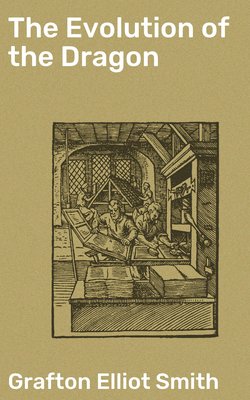Читать книгу The Evolution of the Dragon - Grafton Elliot Smith - Страница 4
На сайте Литреса книга снята с продажи.
ILLUSTRATIONS IN THE TEXT.
ОглавлениеTable of Contents
PAGE
Fig. 1.—Early representation of a "Dragon" compounded of the forepart of an eagle and the hindpart of a lion (from an Archaic Cylinder-seal from Susa, after Jequier) 79
Fig. 2.—The earliest Babylonian conception of the Dragon Tiamat (from a Cylinder-seal in the British Museum, after L. W. King) 79
Fig. 3.—Wm. Dennis's drawing of the "Flying Dragon" depicted on the rocks at Piasa, Illinois 94
Fig. 4.—Two representations of Astarte (Qetesh) 155
Fig. 5.—Pterocera bryonia, the Red Sea spider-shell 170
Fig. 6.—(a) Picture of a bowl of water—the hieroglyphic sign equivalent to hm (the word hmt means "woman"—Griffith, "Beni Hasan," Part III, Plate VI, Fig. 88 and p. 29). (b) "A basket of sycamore figs"—Wilkinson's "Ancient Egyptians," Vol. I, p. 323. (c) and (d) are said by Wilkinson to be hieroglyphic signs meaning "wife" and are apparently taken from (b). But (c) is identical with (i), which, according to Griffith (p. 14), represents a bivalve shell (g, from Plate III, Fig. 3), more usually placed obliquely (h). The varying conventionalizations of (a) or (b) are shown in (d), (e), and (f) (Griffith, "Hieroglyphics," p. 34). (k) The sign for a lotus leaf, which is a phonetic equivalent of the sign (h), and, according to Griffith ("Hieroglyphics," p. 26), "is probably derived from the same root, on account of its shell-like outline". (l) The hieroglyphic sign for a pot of water in such words as Nu and Nut. (m) A "pomegranate" (replacing a bust of Tanit) upon a sacred column at Carthage (Arthur J. Evans, "Mycenæan Tree and Pillar Cult," p. 46). (n) The form of the body of an octopus as conventionalized on the coins of Central Greece (compare Fig. 24 (d)) 179
Fig. 7.—(a) An Egyptian design representing the sun-god Horus emerging from a lotus, representing his mother Hathor (Isis). (b) Papyrus sceptre often carried by goddesses and animistically identified with them either as an instrument of life-giving or destruction. (c) Conventionalized lily—the prototype of the trident and the thunder-weapon. (d) A water-plant associated with the Nile-gods 180
Fig. 8.—(a) "Ceremonial forked object," or "magic wand," used in the ceremony of "opening the mouth," possibly connected with (b) (a bicornuate uterus), according to Griffith ("Hieroglyphics," p. 60). (c) The Egyptian sign for a key. (d) The double axe of Crete and Egypt 191
Fig. 9.—The Egyptian emblem for gold, the sign nub 222
